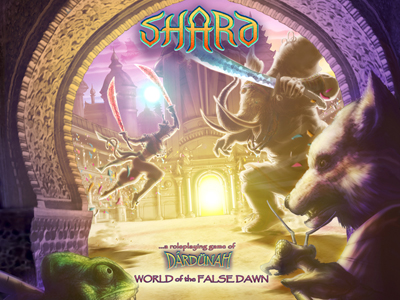Andrew Zimmerman Jones Reviews Shard RPG
 I first discovered the Shard RPG at GenCon in 2009. Despite being one of the most beautiful books I’ve ever seen, I was instantly enthralled by the premise. If the review below wets your appetite, then you can get more information (including a free Welcome Booklet download) from the Shard RPG website.
I first discovered the Shard RPG at GenCon in 2009. Despite being one of the most beautiful books I’ve ever seen, I was instantly enthralled by the premise. If the review below wets your appetite, then you can get more information (including a free Welcome Booklet download) from the Shard RPG website.
Shard RPG Basic Compendium
Aaron de Orive and Scott Jones
Shard Studios (352 pages, $39.99, August 2009)
Reviewed by Andrew Zimmerman Jones
One of the pleasures of going to GenCon is to stumble upon some of the small press games, which are like little treasures sprinkled throughout the dealer’s room. The last time I went, one such treasure was Shard, a game with a spark of originality that is rarely found even in the gaming industry.
Don’t get me wrong, I love traditional fantasy settings and even love the permutations where tradition is turned on its ear, such as the way mythical creatures are portrayed in White Wolf’s World of Darkness line.
But still, there’s something to be said for a game that doesn’t rely on mages, elves, vampires, werewolves, and so on as the basis of their originality.
On the other hand, a good fantasy game does need to be rooted in mythology. Unfortunately, most Western mythologies – from the Greek to the Norse to the Judeo-Christian – have been well looted for game systems over the years. Oriental settings are also somewhat common.
So Shard, which is set in the Hindu-themed world of Dárdünah, is a welcome change (although the game does incorporate many oriental and Asian themes, as well). Dárdünah is truly an alien world, with a core of living crystal which also forms the mountain ranges of the planet. Virtually no metal exists, so weapons and armor are crafted from living organisms (bone, chitin, or even specially-bred living beings, called “suthra”) or from raw materials such as crystals, gems, or stone.
What’s the most unique thing about Dárdünah?
Easy. No humans.
Every player in the game is a different class of anthropomorphic animal, called Zoics. If you’ve been to a convention or watch anime, you’re no doubt familiar with the varied looks of anthropomorphic animals. For example, if you were playing a hedgehog, picture a human-sized “Sonic the Hedgehog” style character.
When creating a Zoic character, you can choose essentially any mammal, bird, amphibian, or reptile as your basis. You can create your own, or use one of the animal templates provided in the book. There are nearly 50 pages of them, from snakes, turtles, mockingbirds, and chickens to walruses, porcupines, and lions.
Character creation is point based, and each animal template costs a certain number of points, with the balance being spent on character-specific traits. You can also buy a Profession Template, ranging from beggar or artisan to noble or treasure hunter – which provides a certain social standing and set of skills.
The combat system is designed to be cinematic in scope (think martial arts films), so you get a variable number of actions and are able to react to any attack immediately as long as you have actions remaining. There’s also a detailed system for ship-to-ship combat for either water vessels or skyships. (Yes, they have skyships!)
Magic in the game falls into four categories: healers, seers, mages, and summoners. The magical power comes from access to the Dream Realm and is performed through rituals, but is a fairly freeform system that allows for a lot of roleplay potential. Certain other skills, such as Alchemy, Suthra Training, and Suthra Use, allow for the creation of impressive “technologies” that are somewhat akin to magical items, such as explosives, living armor, or weapons like the “Amnolish Hive Grenades” or the “Visedi Blowgun Suthra.”
With such a rich setting there is a lot of potential, but one thing that I notice is that it requires a very independent Game Master. If the GM needs loads of supplements and setting details, this just isn’t the game for them. There’s a very detailed backstory of Dárdünah, a couple of maps, and a bestiary, but as for the actual things to do in this world … the GM has to come up with the particulars, perhaps a bit moreso than in systems that provide more suggestions.
For a good Game Master with a good group looking for a new adventure, Shard provides excellent opportunities for adventures that aren’t just rehashing old stories, but are creating something fundamentally new. The game is versatile, so about anything goes. Intrigue and political machinations, piracy, outright war, and so on are all presented in the all-too-brief section on running a game.
And, hey, what game (other than perhaps Toon) would allow you to play a magic-wielding glassblower chicken turned sky pirate?
This review originally appeared in Black Gate 14.
Andrew, are you going to GenCon this year?